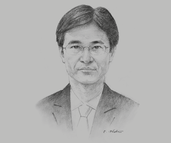Toshiro Hayashi, CEO, Toyota del Perú: Interview

Interview: Toshiro Hayashi
What are some of the automotive sector’s mediumto long-term expectations?
TOSHIRO HAYASHI: The selective excise tax increase in the second quarter of 2018 caused a significant drop in revenue and sales to all sector players, with figures down 10% from the previous year. However, the anticipated 2019 GDP growth will permit most figures to bounce back to their 2017 levels, with growth rates in the sector usually mimicking those of overall GDP. Similarly, the abolition of some excise taxes for pickup trucks in 2018 boosted sales in that segment, and helped avoid a more significant drop in overall figures for the sector. Many potential SUV buyers have turned to pickup trucks because of this excise tax exemption.
The increasingly strong presence of Chinese auto brands in the Peruvian market will also undoubtedly alter the current landscape of the sector overall. While initial sales rates have been high, the experiences of other newcomers, like Korean manufacturers in the US in the late 1980s, tell us that very high sales can only be sustained over a short period of time – usually no more than two or three years. After that, sales drop significantly because newcomers do not possess the distribution and after-sales services networks that well-established brands have. This will likely be the case of some Chinese auto companies in Peru. Chinese brands have targeted both low- and middle-income segments. While prices offered for the former are lower than most of the competition, prices for middle-income segments are much closer than its Japanese, South Korean, EU and US counterparts.
How can Peru fully transition to electric cars?
HAYASHI: The expansion of the electric car market in Peru is limited by the scarcity of plugs and charging stations in Lima and elsewhere. The country lacks a consistent set of regulations that allow the necessary infrastructure to be installed systematically. Hybrid car sales, which can be seen as a first step towards fully autonomous electric cars, have been steadily increasing in Peru over the past years. Moreover, the country needs an appealing set of tax incentives, grants and low-interest loans to promote the sale of electric cars, as has been the case in the US, EU and Japan. The current price differences, coupled with the lack of charging infrastructure, deters the mass adoption of hybrid and – at a later stage – electric cars in Peru.
Could Peru become a major hub for car production?
HAYASHI: In the past, when global value chains were not as tightly integrated as they are now, Peru had a number of assembly plants. The country’s high excise taxes on imported goods made importing fully assembled cars unviable economically. Most brands relied on assembly kits used by manufacturers, which were assembled on Peruvian soil. Two decades ago, the disappearance of high tariffs and specific excises for imported cars resulted in the total loss of the national automotive parts industry, as it had relied on a protectionist import regime to exist.
Despite significant and continuous growth rates, Peru’s market size is limited and small compared to countries with larger populations, such as Brazil, or those with higher incomes per capita, like Chile and Argentina. The presence of a local automotive sector is closely linked to a country’s long-term economic and industrial policies. Both Chile and Peru realised in the 1990s that such industry would not be competitive, preferring to divert efforts and investment towards other sectors where they believed there to be more significant competitive advantages, while importing fully assembled cars. This situation is very unlikely to change in the medium term, since the country’s relatively low tariff for imported cars, which stands at 6%, does not make it viable for automotive companies to establish plants here. This is notable when compared to other local markets, such as Brazil and Argentina, where tariffs are as high as 40% of the imported car’s value.
You have reached the limit of premium articles you can view for free.
Choose from the options below to purchase print or digital editions of our Reports. You can also purchase a website subscription giving you unlimited access to all of our Reports online for 12 months.
If you have already purchased this Report or have a website subscription, please login to continue.

